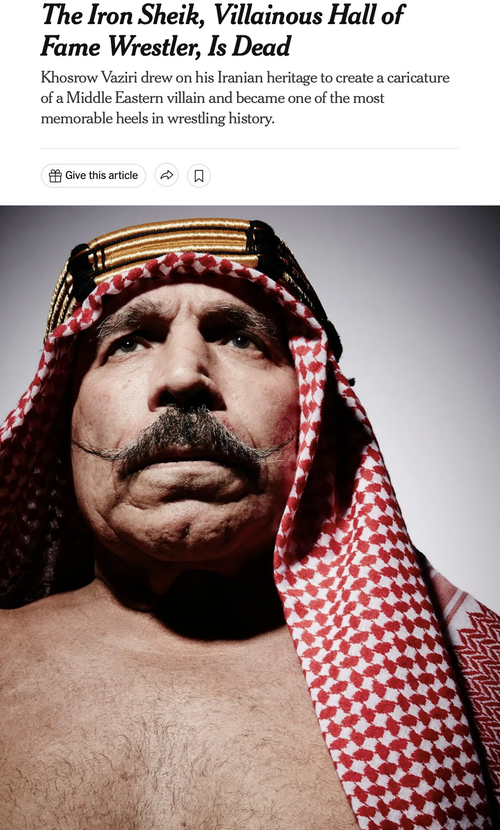Thanks to Iran's Islamic revolution, 9/11, large-scale immigration, and much else, Americans have learned a great deal about the Islam of Muhammad and the Qur'an over recent decades. Terms such as Ramadan, shariah, and jihad, for example, have become widely familiar.
Fewer, however, know about an indigenous American form of Islam, the black folk religion that began about a century ago in cities like Newark, Chicago and Detroit, and the inspiration behind Louis Farrakhan and the Million Man March.
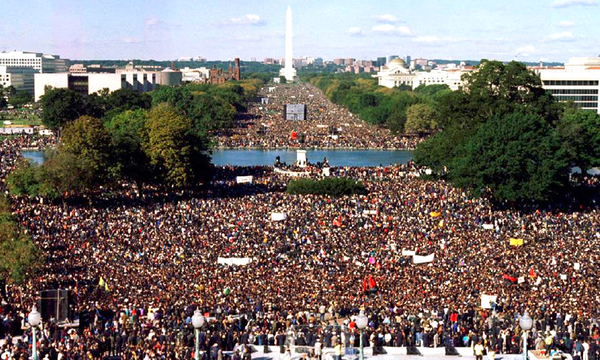 The Nation of Islam's Million Man March in Washington, D.C., took place on October 16, 1995. |
America's indigenous version of Islam contains key tenets that deeply contradict those of normative Islam, most prominently by adding prophets after Muhammad, viewing whites as evil and restricting membership to persons of African heritage. Noble Drew Ali's Holy Koran of the Moorish Science Temple of America (1927) contains no overlap with the normative Qur'an but derives from such books of "esoteric wisdom" as The Aquarian Gospel of the Christ (Los Angeles, 1908). For these reasons, Muslims generally reject MSTA's claims to be Islamic.
While its later evolution is generally familiar—the Moorish Science Temple of America (MSTA) emerged in 1925, its successor the Nation of Islam five years later—its origins have long remained murky. Who was the key figure behind this radically different form of Islam? And whence derived his irregular ideas?
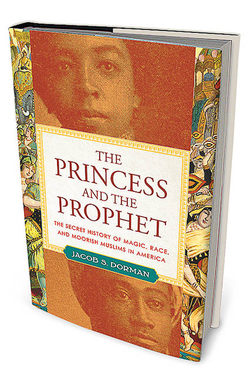 "The Princess and The Prophet" cover. |
Through 13 years of detective work in "twenty-six theatrical, religious, fraternal, and historical archives" (including the archive at Circus World in Baraboo, Wisconsin), Mr. Dorman has discovered a great deal about the key founder of African-American Islam, Noble Drew Ali. As he explains, this self-styled prophet is ultimately why Malcolm Little became Malcolm X and Cassius Clay became Muhammad Ali; why the Nation of Islam exists as it does today; and why about 700,000 American blacks are now adherents of Islam.
Just who was Noble Drew Ali? Mr. Dorman identifies him as John Walter Brister (1879-1929) and devotes much of his book to tracing Brister's short, eventful life: Born in Carlisle, Kentucky, he played the cornet in an 1890s vaudeville show, becoming the first-ever black child star on Broadway. He then worked as a "Hindoo" magician, marrying a leading black vaudeville actress of the 1900s, who performed as the "princess" of the title. In the 1910s he became a quack "Egyptian Adept" physician. Finally, he presented himself as a "Moor," the Prophet Noble Drew Ali, and established the MSTA. This new organization fit the temper of its time and place, the Chicago of Al Capone and of the Great Migration of blacks from the South. Within just months, he won about 7,000 followers, achieving notable economic and political success. But in 1929, amid Chicago's endemic violence, Drew Ali died in still-mysterious circumstances, aged 50.
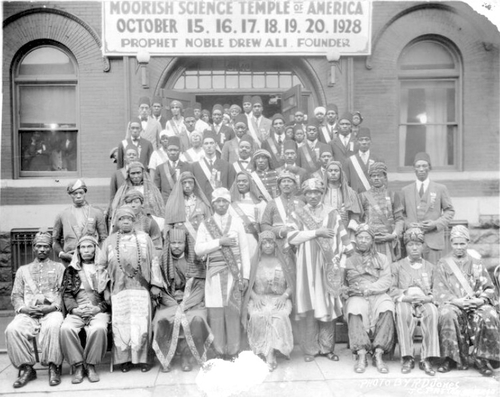 Noble Drew Ali at the peak of his power and renown with MSTA members in October 1928, standing in the front row, fifth from left, with the "princess" by his side. |
Mr. Dorman places the MSTA firmly in its cultural milieu, and here things get really interesting. He shows how, from the 1830s, Americans had a benign fascination with and even a respect for the Middle East and Islam, making Asian, Islamic, Arab and Moorish themes widespread in the golden age of vaudeville and the circus. (Note Brister's successive Indian, Egyptian and Moorish personae.)
Thus, a group of New York Freemasons in 1870 founded the Ancient Arabic Order of the Nobles of the Mystic Shrine – known as the Shriners. In 1889, Barnum & Bailey circus advertised "A Desperate Sortie by Real, Mounted Moorish Warriors upon the Besieging French Legions, an Actual Scene in the Grand Wild Moorish Caravan and Arabian Entertainment." In 1893, the rival Sells Brothers Circus featured an "Orientally Splendid and Weirdly Romantic Spectacular Pilgrimage to Mecca." That same year also brought many popular and authentic Muslim exhibitions to the World's Columbian Exposition in Chicago, including its working mosque and real muezzin.
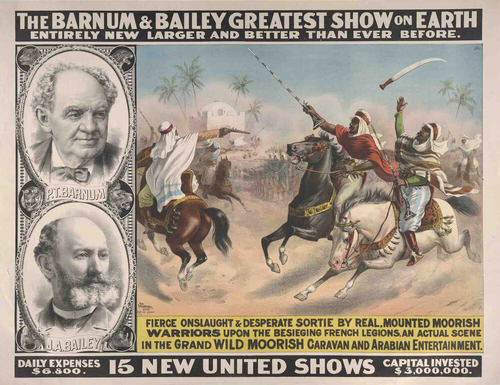 A Barnum & Bailey circus poster from 1889. |
For whites, watching pseudo-fakirs or swearing a "Moslem's oath" at New York's Mecca Temple offered a raucous good time; in Mr. Dorman's words, it served as a way to "release their Westernized, workaday woes and enjoy a carefree, absurd Orientalist spectacle." But for blacks, Oriental themes took on a much deeper meaning. Being "Hindoo," "Egyptian," or, especially, "Moorish" implied not being from Africa, and offered an escape from racism, a way of avoiding the stigma associated with African heritage. What began as a lark took on serious, even reverential overtones.
Indeed, Mr. Dorman's account shows how some of the MSTA's distinctive characteristics live on in the Nation of Islam and beyond, even among black American Sunnis and Shia. These include patriarchal families, an emphasis on personal hygiene and clean living, the leader's claim to prophethood, a mix of Christian and Muslim elements, the idea of a paramount "scientist," distinctive clothing, and institutions to attain economic self-sufficiency.
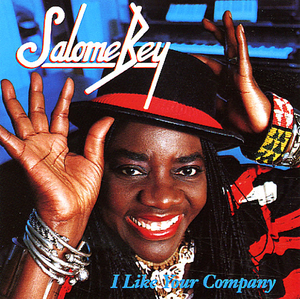 Salome Bey's 1992 record, "I Like Your Company." |
African-American Islam has receded since 1975, increasingly replaced by normative Islam, a trend that will likely accelerate with the passing of the Nation of Islam's current leader, Louis Farrakhan, now 87. But Noble Drew Ali and the MSTA have earned a permanent place in American history by serving as the original bridge for 700,000 American blacks, and likely many more in the future, to move from Christianity to Islam.
Mr. Pipes is president of the Middle East Forum. © 2020 by Daniel Pipes. All rights reserved.
Nov. 23, 2020 update: Philip Jenkins in "Spread The Picture On A Wider Screen" places the Brister-MSTA phenomenon in the unexpected context of "the easy transition" from the realm of the entertainment world to the world of new or made-up religion. The two share "play-acting, impersonation, exoticism, dressing up, and spectacle." He mentions Achmed Abdullah, Wallace Fard, William Dudley Pelley, Albert P. Warrington, L. Ron Hubbard, and Anton LaVey, "Whatever form they take – stage, screen, or new religion – dreams are dreams, and scripts are scripts. Circus tents can morph into revival tents."
Feb. 25, 2023 update: John Kelly discusses the Shriners taking over the American capital nearly a century ago, at "In June 1923, Washington was transformed into the Middle East."
June 7, 2023 update: For a current example of how a Muslim identity serves in American entertainment, see the obituary of the "Iron Sheik," aka Khosrow Vaziri.
